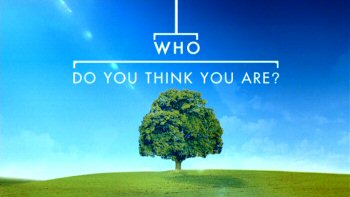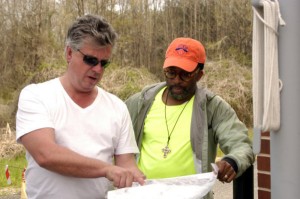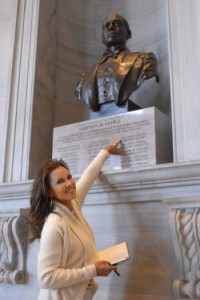Mediating the Past: History and Ancestry in NBC’s Who Do You Think You Are?
 **This post is part of our series, Mediating the Past, which focuses on how history is produced, constructed, distributed, branded and received through various media.
**This post is part of our series, Mediating the Past, which focuses on how history is produced, constructed, distributed, branded and received through various media.
NBC’s Who Do You Think You Are? (WDYTYA?) transports viewers through time and space by tracing American celebrities’ ancestries. The show is one of ten international offshoots from the BBC’s show of the same name. Each episode of NBC’s version follows the genealogy of a well-known celebrity. In its three seasons, the show has featured the family trees of Steve Buscemi, Rashida Jones, Gwyneth Paltrow, Sarah Jessica Parker, and Martin Sheen, among others. For each episode, the show’s research team works with corporate sponsor Ancestry.com’s genealogists to trace one or more lines of the celebrities’ family trees. The documentary-style show takes the celebrities to the locations of their historic family moments, both in the United States and abroad, and chronicles their reactions to the historians and historical documents that reveal their ancestors’ pasts. The show is based upon a premise that is repeated in the show’s title sequence, “To know who you are, you have to know where you came from.”
WDYTYA? is fascinating because it tells histories that are different from those most Americans learn from textbooks and celebrated national stories. To help viewers understand the triumphs and injustices uncovered while researching each celebrity’s history, the series regularly includes brief segments that give viewers relevant historical context. Though critics and viewers have largely overlooked the series (its cancellation in May 2012 received no fanfare), its stories are rich and compelling historical lessons about immigration, assimilation, gender, race, and class—their emphasis on both diversity and unity echoes the discourse of the American “melting pot.” Some of the most compelling episodes, however, are those where relatively little information about a celebrity’s ancestors can be found. These episodes shine a light on the fact that the histories of Americans with little economic, political, or cultural power were recorded unevenly (or not recorded at all), and usually focus on one of the United States’ most shameful and devastating practices: slavery.
 Through the ancestries of Spike Lee, Emmitt Smith, Vanessa Williams, Lionel Richie, Blair Underwood, and Jerome Bettis, we learn about “the wall” many African Americans hit when trying to uncover their histories. In each of these episodes, we watch disappointed and frustrated Black celebrities learn that their ancestors’ histories are segregated in documents like the “Slave Schedule” (a census-like document used to collect information about slaves), which lists the number and characteristics (sex, age, color, literacy, mental capacity) of slaves owned, but infrequently contains their names. Instead of the typical “go-to” sources white celebrities use to locate their family histories, Black celebrities must read the diaries and wills of slave-owners to find faint traces of their family members’ fates. And unlike the other celebrities WDYTYA? features, many Black celebrities cannot visit their family members’ graves because their burial sites were only marked provisionally, if at all.
Through the ancestries of Spike Lee, Emmitt Smith, Vanessa Williams, Lionel Richie, Blair Underwood, and Jerome Bettis, we learn about “the wall” many African Americans hit when trying to uncover their histories. In each of these episodes, we watch disappointed and frustrated Black celebrities learn that their ancestors’ histories are segregated in documents like the “Slave Schedule” (a census-like document used to collect information about slaves), which lists the number and characteristics (sex, age, color, literacy, mental capacity) of slaves owned, but infrequently contains their names. Instead of the typical “go-to” sources white celebrities use to locate their family histories, Black celebrities must read the diaries and wills of slave-owners to find faint traces of their family members’ fates. And unlike the other celebrities WDYTYA? features, many Black celebrities cannot visit their family members’ graves because their burial sites were only marked provisionally, if at all.
 The most compelling moments in episodes of WDYTYA? that feature Black celebrities come when they can break through “the wall.” For example, Bettis feels pride when he learns that his three-times-great-grandfather, hit by a steam engine, successfully sued the Illinois Central Railroad; and Williams is humbled to learn her great-great-grandfather risked his life as a Black union soldier fighting in the American south. Further, WDYTYA? uses DNA tests to trace Underwood’s and Smith’s ancestors to particular villages in Africa, and in Underwood’s case, introduces him to a distant relative. These episodes end with cathartic pride as Black celebrities reclaim pieces of their family histories that at first seemed unrecoverable. These inspiring emotional moments, however, overshadow the fact that the experiences of Black women who shaped and, quite literally, birthed these histories, are absent.
The most compelling moments in episodes of WDYTYA? that feature Black celebrities come when they can break through “the wall.” For example, Bettis feels pride when he learns that his three-times-great-grandfather, hit by a steam engine, successfully sued the Illinois Central Railroad; and Williams is humbled to learn her great-great-grandfather risked his life as a Black union soldier fighting in the American south. Further, WDYTYA? uses DNA tests to trace Underwood’s and Smith’s ancestors to particular villages in Africa, and in Underwood’s case, introduces him to a distant relative. These episodes end with cathartic pride as Black celebrities reclaim pieces of their family histories that at first seemed unrecoverable. These inspiring emotional moments, however, overshadow the fact that the experiences of Black women who shaped and, quite literally, birthed these histories, are absent.
 This is particularly frustrating given that many celebrities, like Lee and Underwood, begin their journey hoping to explore the ancestry of a beloved female relative. Bettis’ episode, for example, is driven by his desire to learn more about his mother’s ancestry, yet glosses over evidence that his great grandmother and grandmother were abandoned in the early 1900s, and focuses instead on his great grandfather’s bravery for taking legal action against his abusive white employer at a spoke factory. WDYTYA? sidesteps discussion of enslaved Black women’s experiences of master-slave rape with euphemisms like “commingling” in Smith’s episode. Similarly, Richie passes over evidence that his enslaved great-great-grandmother was raped and praises his ancestor’s slave master for providing for his own mulatto children, saying, “to protect what was his was just the greatest gift.” Only Lee acknowledges his mulatto heritage is a product of slave rape, but neither he nor the show explore what that reality might have been like for his ancestors or Black women more generally.
This is particularly frustrating given that many celebrities, like Lee and Underwood, begin their journey hoping to explore the ancestry of a beloved female relative. Bettis’ episode, for example, is driven by his desire to learn more about his mother’s ancestry, yet glosses over evidence that his great grandmother and grandmother were abandoned in the early 1900s, and focuses instead on his great grandfather’s bravery for taking legal action against his abusive white employer at a spoke factory. WDYTYA? sidesteps discussion of enslaved Black women’s experiences of master-slave rape with euphemisms like “commingling” in Smith’s episode. Similarly, Richie passes over evidence that his enslaved great-great-grandmother was raped and praises his ancestor’s slave master for providing for his own mulatto children, saying, “to protect what was his was just the greatest gift.” Only Lee acknowledges his mulatto heritage is a product of slave rape, but neither he nor the show explore what that reality might have been like for his ancestors or Black women more generally.
WDYTYA?‘s efforts to break through “the wall” by uncovering and narrating our ancestors’ lost stories are vitally important. Still, as compelling and significant as Black men’s narratives are, their histories are incomplete without Black women’s voices. And, considering the show’s inclusion of white women’s historical narratives (notably in episodes featuring Susan Sarandon and Helen Hunt), the omission of Black women’s experiences is all the more problematic. Though our female ancestors’ stories have long been overshadowed by their husbands’ and fathers’ histories, Black women’s historical narratives tell equally important and compelling stories–and they should be told on WDYTYA? and elsewhere, no matter how fragmented or uncomfortable. Without Black women’s stories, we can never really know “who we are” or “where we came from.”



The show’s been CANCELLED?! Nooooooooooooo! (Enjoyed your post, btw.) =)
When I read this great post, I had a moment of confusion: while Rashida Jones (who is, of course, the daughter of Quincy Jones) was mentioned in the list of celebrities featured on the show, she is not among those mentioned in the discussion of African Americans exploring their history.
Accordingly, I did some digging on Google, and discovered the reason: in the ultimate case of mediating the past, Rashida Jones’ episode focused exclusively on her maternal lineage. I found that an interesting decision within the context of this post, and would be curious to know if anyone has seen the episode and has any perspective on how that narrowing was framed.
I’ve seen it, and from what I recall, Quincy Jones had already spent a great deal of time digging through his family tree; as such, Rashida was already familiar with that side of her family. On the other hand, her mother’s (Jewish) heritage — and especially that of Rashida’s grandmother (who had some mysterious and “unaccounted for” years) — was less clear. So she (the show?) decided to focus on that.
There’s more in the recap here: http://www.nbc.com/who-do-you-think-you-are/episode-guide/season-3/460306/rashida-jones/episode-310/499266/
I also wonder if Rashida Jones becomes problematic because she is not mediated as black. If we historically look at the romantic roles in which she has been cast, she is always paired with a white man, thus making her not black, but at the very least, racially ambiguous.
Hi folks, thanks for your comments–I’m sorry to be late to the party, I’ve been traveling. Kelli, thank you for answering Myles’ question–that’s just what I would’ve said.
What’s interesting about the show is that it reveals how “mixed” many people’s ancestries are–so certainly Rashida Jones’ non-Black ancestry is just as interesting as I’m sure her Black ancestry is, and what I like about her episode is that it really complicates how we think about folks with “mixed race.” I’m looking forward to spending some more time with Mary Beltran’s work, for example, when we look at episodes like Jones’ when we get deeper into our larger project. So Alfred and Myles: Rashida Jones may be half black, but the episode encourages us to think a bit more carefully about that–maybe she’s cast in “white” roles because SHE sees herself that way? And does having a Black father mean you’re Black??
From talking with an executive producer and the head of research for the show, we learned that when a celebrity comes to them, they do preliminary research on many lines of the ancestry (not just the ones they’re most interested in exploring) to see what might be the most interesting for TV. The appeal of the story, of course, impacts the ancestry lines that the show explores.
And Kelli: the production team is working to find a new home for the show. I have all of my fingers and toes crossed that season 4 will find a new home–NBC’s loss! 🙂
Good point, however, I guess my question is why this is more appealing? Or rather, not why, but what does that do, ideologically? Let us not forget that pleasure and appeal are not innocent, there are values there, and even if Rashida Jones plays herself as white, (although I suspect this is more of complex negotiation between her agent, producers, and more), what does it do to value her whiteness? Just because she is familiar with her father’s side of the family, doesn’t mean audiences are, and so I guess I just want to trouble our analysis of her episode, and consider the producers discretion in deciding what aspects of Jones’ heritage to pursue, and why that may have seemed more appealing. I love this post, I think it brings up some great questions about race and television, and I think Rashida Jones’ and Vanessa Williams mixed race ethnicity is certainly significant to how WDYTYA is portraying non-white females, although I am not sure if there is just one fixed significance. One reading could be that lighter skinned, pan ethnic non-white female guests are more familiar, more ambiguously white and yet non-white, and producers think this ambiguity will cast a larger audience net.
Great post, looking forward to seeing where WDYTYA’s ends up.